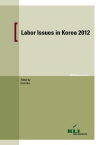한국노동연구원 'Publications in English'에 대한 설명 입니다.
Publications in English
Publications in English

Labor Issues in Korea 2012
- Author Edited by Hoon Kim
- Publication Date 2014.06.20
- Length 222
- ISBN 978-89-7356-981-6
Content
Chapter 2. Study on Working Conditions and Informal Employment in the Labor Market for Care Workers (Deok Soon Hwang)
Chapter 3. Informal Work in Korea: Causes, Characteristics and Consequences (Byung-Hee Lee)
Chapter 4. Determinants of Corporate Employment Performance (Yoon-Gyu Yoon)
Chapter 5. Baby Boomers’ Employment (Joyup Ahn and Bogsoon Kim)
Chapter 6. Collective Disputes and Dispute Resolution Systems in South Korea: From Controlling Interventions to Evolutionary Institutionalized Regulation (Kiu-Sik Bae)
Chapter 7. Changing Trends in the Youth Unemployment Crisis: 2004~2011 (Jae-ho Keum)
Summary
This year’s Labor Issues in Korea 2012 includes papers on issues of industrial relations, care work, informal employment, corporate management performance, employment for baby boomers, and labor dispute resolution.
Seong-Jae Cho (Chapter 1) explores future directions for the development of industrial relations on the basis of an analytical understanding of previous and current Korean labor regimes and industrial relations systems. This chapter combines historical and systemic approaches. Deok Soon Hwang (Chapter 2) looks at the characteristics of Korea’s care-worker labor market and examines working conditions and informal employment in this market segment. He suggests policy measures for converting this informal employment to formal employment. Byung-Hee Lee (Chapter 3) analyzes the characteristics and causes of informal employment in Korea that expanded with the rapid increase of labor market flexibility after the 1997 Asian financial crisis. Yoon-Gyu Yoon (Chapter 4) uses results of the KLI Workplace Panel Survey (2005?2009) to empirically analyze corporate employment performance and identify its key determinants. Joyup Ahn and Bogsoon Kim (Chapter 5) compare the employment status of the baby boom generation (those born during the period 1955?1963) with that of the generations immediately before (born during the period 1950?1954) and after (born during the period 1964?1968), based on a number of labor market indicators, to review the intergenerational changes in patterns of economic activity. Kiu-Sik Bae (Chapter 6) reviews how South Korea has developed and institutionalized collective dispute resolution systems during the period of the country’s compressed industrialization. Finally, Jae-ho Keum (Chapter 7), using raw data from the Economically Active Population Survey of the National Statistical Office of Korea, analyzes difficulties youths face in gaining employment by gender, age, and level of educational attainment. He examines the impact of such difficulties on the quality of youth employment.
This book introduces readers to pending issues in the Korean labor market and provides in-depth discussions on newer issues and related policies. It also evaluates the effectiveness of these policies.
 Source Indication + Commercial Use Prohibition + Change Prohibition
Source Indication + Commercial Use Prohibition + Change Prohibition